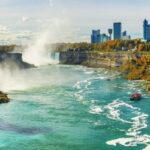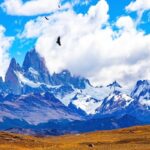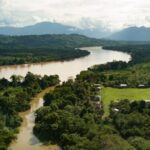We explain everything about America, its climate, flora, fauna and other characteristics. Also, the countries that make it up and their culture.

What is America?
America It is the second largest continent of the four on the planet and due to its great extension It is divided into three regions: North America, Central America and South America. It borders only oceans (like Oceania, the smallest of the continents).
The continent It was discovered by Europeans in 1492 thanks to the Genoese Christopher Columbus who set sail with three caravels from the Port of Palos (Spain) and sailed for 71 days until sighting dry land. However, Columbus died thinking that he had circumnavigated the world and had reached an unknown territory on the Asian coast.
Before that date, America was inhabited by great civilizations called “pre-Columbian”, such as the Inca Empire, the Mesoamerican cultures of the Mayans, Aztecs, Zapotecs, Olmecs and Toltecs, among others.
Over the years, the inhabitants of the “old continent” (Europe, Africa and Asia, since Oceania had not yet been discovered), made sea voyages to Central America and conquered various peoples, through strategies or through strength, and they called this territory the “New World.”
Several navigators, including Américo Vespucio, Juan de la Cosa and Martín Waldseemüller, made different trips to the “New World” with the aim of expanding European trade.
In 1499, the Florentine Amerigo Vespucci was the first to suggest that it was a new land mass different from the Asian Indies, because it had a much larger and more diverse population than that of Asia, Africa or Europe. In honor of his deductions, the name of the continent arose.
See also: Latin America
Characteristics of America
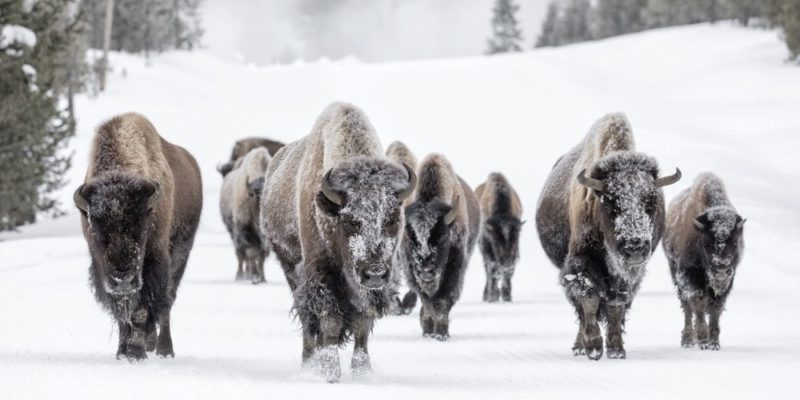
The American continent It has an extension of 14,000 kilometers from Alaska (Canada) to Tierra del Fuego (Argentina) and has an area of 42,549,000 square kilometers (8.3% of the total land surface). It has long mountain ranges such as the Rocky Mountains in North America or the Andes in South America.
Next, we will describe the main characteristics of the climate, flora, fauna and culture of America:
Climate of America
America It is the continent with the greatest climatic variety due to its extension and various factors such as water, wind and temperature. For example, the climate in the far north of the continent is subarctic or boreal, year-round.
In much of Canada and Alaska, and in the Patagonian region of Argentina in the extreme south of the continent, the climate is intensely cold with snowfall during the winter season. The hottest temperatures are recorded in the regions furthest from the poles but there are also areas where it usually snows.
For example, in the northwest of Mexico: in the Sierra de Sinaloa and Chihuahua (which can be traveled through the Chihuahua Pacific Railway), in the forest of the Mexiquillo Natural Park in Durango, in the town of Sombrerete in Zacatecas and in the forests Monterreal de Coahuila.
In the north of South America the climate is warm and is classified as tropical, equatorial and desert. In the central region of South America, a temperate (or warm) climate predominates, which is classified as oceanic temperate (close to the coast) and continental temperate (deep into the continent).
Flora and fauna of America
America has very varied ecosystems and the greatest biodiversity on the planet. Depending on the region of the continent, the flora and fauna have certain characteristics:
- Flora and fauna in North America Trees such as pines, mahoganies, cedars, conifers and plants such as cacti and agaves abound. Among the animal species there are bears, eagles, Canadian sheep, turkeys, seals, American bison, ocelots, deer, wolves, coyotes and snakes.
- Flora and fauna in Central America Trees such as avocados, guavas, tamarinds, palms, bananas, cherries and pineapples and plants such as cocoa, chili and corn abound. Among the animal species there are tapirs, armadillos, macaws, quetzals, green frogs, flamingos, howler monkeys, jaguars, anteaters, eagles, pumas and tapirs.
- Flora and fauna in South America Trees such as larches, cypresses, araucarias, coligües (or canes), lengas, pines, guamos, caobos and vines and plants such as ferns, banana trees, Amazonian victory flowers, roses and orchids abound. Among the animal species there are penguins, whales, jaguars, pumas, toucans, condors, rattlesnakes, crocodiles, and manatees.
Culture of America
America It is characterized by its wide cultural diversity. The native or indigenous peoples who inhabited the continent before the discovery and Spanish colonization had managed to establish large empires. Subsequently, the population changed and grew throughout history, mainly due to the arrival of immigrants from the “old world.”
After the arrival of Columbus, Europeans explored and colonized new lands. The Spanish occupied the regions from Mexico to the south of the continent, the Portuguese the region of Brazil, and the English and French occupied North America. New languages and customs developed as a result of colonization different from those practiced by indigenous people.
Despite its cultural diversity, the continent is divided into two very demarcated regions according to the predominant language and its economic growth:
- Anglo-Saxon America It includes Canada and the United States, and the English language predominates.
- Latin America It extends from Mexico to Argentina, and Spanish-speaking languages predominate.
American countries
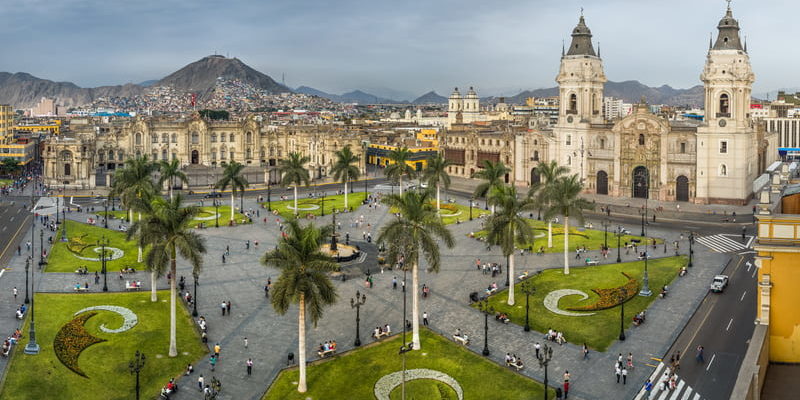
The American continent has 35 sovereign (or independent) countries: 3 in North America, 7 in Central America, 13 in the Caribbean Sea and 12 in South America.
The name of each country and its respective capital city are:
In North America:
- Canada Capital: Ottawa
- USA Capital: Washington DC
- Mexico Capital: Mexico City
In Central America:
- Belize Capital: Belmopan
- Costa Rica Capital: San José
- El Salvador Capital: San Salvador
- Guatemala Capital: Guatemala City
- Honduras Capital: Teguacigalpa
- Nicaragua Capital: Managua
- Panama Capital: Panama
In the Caribbean Sea:
- Antigua and Barbuda Capital: Antigua and Barbuda
- Bahamas Capital: Commonwealth of the Bahamas
- Cuba Republic of Cuba
- Dominica Capital: Commonwealth of Dominica
- Grenade Capital: Granada
- Haiti Capital: Port-au-Prince
- Jamaica Capital: Jamaica
- Dominican Republic Capital: Santo Domingo
- Saint Kitts and Nevis Capital: Federation of Saint Kitts and Nevis
- Saint Vincent and the Grenadines. Capital: Kingstown
- Saint Lucia Capital: Saint Lucia
- Trinidad and Tobago Capital: Port of Spain
In South America:
- Argentina Capital: Buenos Aires
- Bolivia Capital: Sucre
- Brazil. Capital: Brasilia
- Chili. Capital: Santiago de Chile
- Colombia Capital: Bogota
- Ecuador Capital: Quito
- Guiana Capital: Georgetown
- Paraguay Capital: Asuncion
- Peru Capital: Lima
- Surinam Capital: Paramaribo
- Uruguay Capital: Montevideo
- Venezuela Capital: Caracas
Countries under foreign sovereignty:
- Costa Rica (under the sovereignty of the United States). Capital: San Juan
- French Guiana (under the sovereignty of France) Capital: Cayenne
- Greenland (under the sovereignty of Denmark) Capital: Nuuk
Map of America
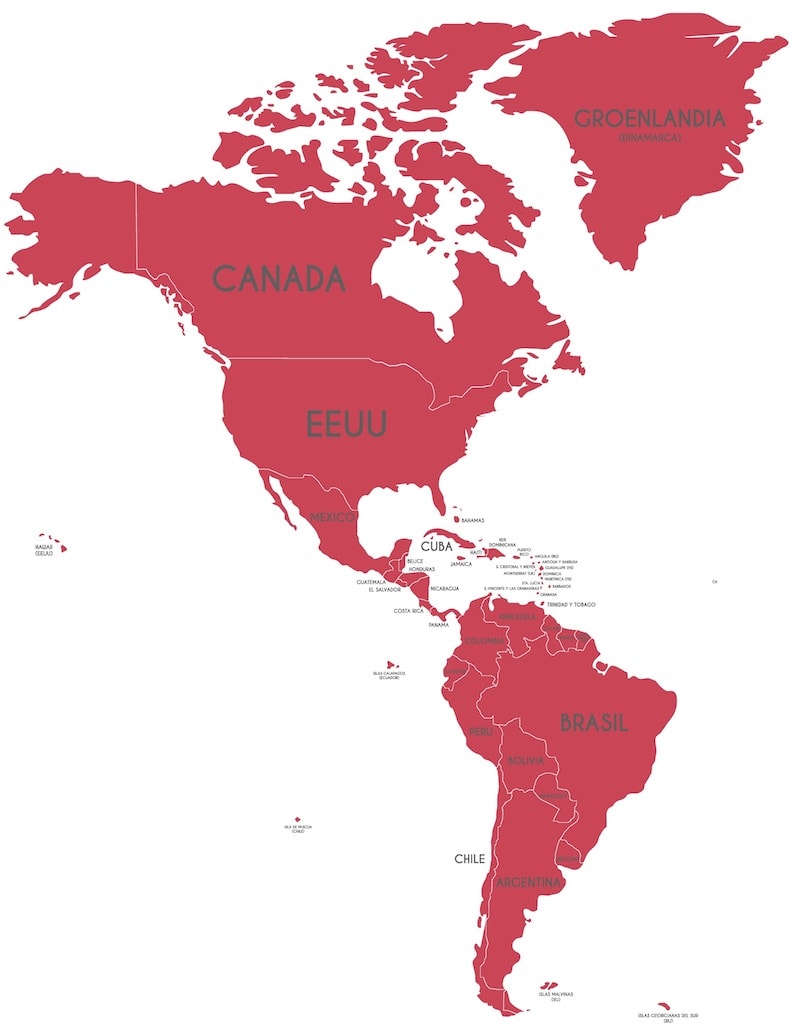
Limits of America
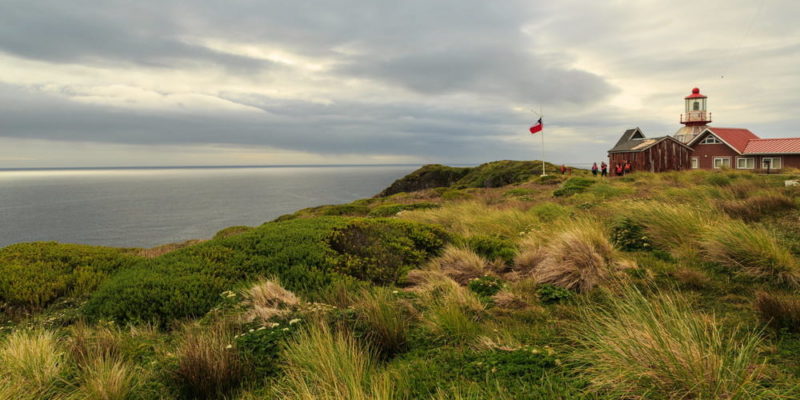
The American continent borders three oceans:
- In the north it borders the arctic glacier ocean.
- In the south it borders the confluence of the Pacific and Atlantic oceans.
- In the east it borders the Atlantic Ocean.
- In the west it borders the Pacific Ocean.
The other continents
There are 6 continents on the planet in total: Africa, America, Europe, Asia, Oceania and Antarctica (the southernmost, with an approximate population of 4,000 inhabitants in summer and 1,000 in winter).
References
- «The discovery of America» (video) on Academia Play.
- “Why is the continent called America?” (video) at Bully Magnets.
- “Copper Canyons” in Chepe.
- “It's snowing again in the upper part of the mountain region” in Debate.com.mx.
- “Characteristics of the American population” in Abc.com.py.


